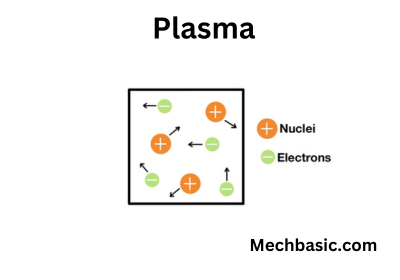CONTENTS

Phase of Matter
In thermodynamics, phases of matter refer to the distinct forms that different phases of matter can take depending on the temperature and pressure conditions. The four most common phases are solid, liquid, gas, and plasma. The behavior of matter in each phase is governed by its thermodynamic properties such as pressure, temperature, and volume, and phase transitions occur as these conditions change.
Here’s a breakdown of the phases of matter and their thermodynamic characteristics:
Solid Phase

- Description: In the solid phase, particles (atoms, molecules, or ions) are closely packed together and vibrate around fixed positions. This results in a fixed shape and volume.
- Thermodynamic Properties:
- Low entropy: The particles are in a highly ordered arrangement, which means low disorder (low entropy).
- High internal energy: The energy in the form of potential energy between particles is relatively high due to their fixed positions.
- Strong intermolecular forces: The forces between particles (like ionic, covalent, or metallic bonds) are very strong.
- Phase Transition: Solid to liquid (melting) occurs when heat is added, increasing the energy and allowing particles to move more freely.
Liquid Phase
- Description: In the liquid phase, particles are still close together, but they have enough energy to move past one another, giving liquids the ability to flow and take the shape of their container. The volume remains relatively fixed, but the shape is not fixed.
- Thermodynamic Properties:
- Moderate entropy: Liquids have more freedom of movement compared to solids, so they have higher entropy (greater disorder).
- Moderate intermolecular forces: The forces between particles are weaker than in solids but still significant enough to maintain a definite volume.
- Energy content: The energy required to change the phase from solid to liquid is the latent heat of fusion.
- Phase Transition: Liquid to gas (vaporization) or liquid to solid (freezing) depending on the temperature and pressure conditions.
Gas Phase
- Description: In the gas phase, particles are far apart and move freely at high speeds. Gases do not have a fixed shape or volume and will expand to fill the container they occupy.
- Thermodynamic Properties:
- High entropy: Gas particles are in a state of high disorder, with a large number of possible configurations.
- Very weak intermolecular forces: The forces between gas particles are negligible, which allows them to move freely and spread out.
- Low density: Gas particles are far apart, leading to low density compared to liquids and solids.
- Phase Transition: Gas to liquid (condensation) or gas to solid (deposition) can occur depending on changes in temperature and pressure.
Plasma Phase

- Description: Plasma is a high-energy state of matter where the particles are ionized, meaning that electrons are stripped from atoms, creating a mix of free electrons and positively charged ions. Plasmas are commonly found in stars and lightning.
- Thermodynamic Properties:
- Extremely high energy: The particles in plasma have extremely high kinetic energy due to the high temperature.
- Very high entropy: The disorder in plasma is very high, as free electrons and ions are constantly in motion.
- Electrically conductive: Plasmas can conduct electricity and are influenced by magnetic fields.
- Phase Transition: Plasma to gas (recombination) happens when the temperature decreases, allowing electrons to recombine with ions.
AlSO READ:
- Phase Transitions.
- Phase Diagrams.
- Triple Point.
